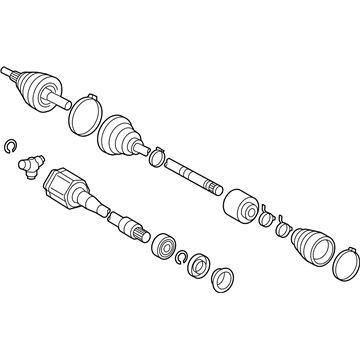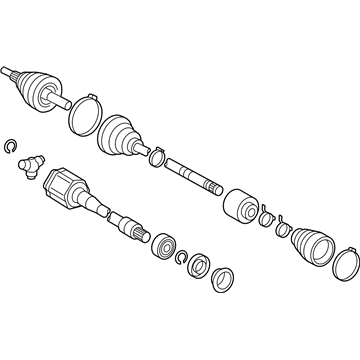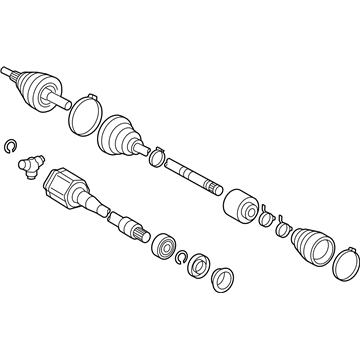×
ToyotaParts- Hello
- Login or Register
- Quick Links
- Live Chat
- Track Order
- Parts Availability
- RMA
- Help Center
- Contact Us
- Shop for
- Toyota Parts
- Scion Parts
My Garage
My Account
Cart
OEM 2010 Toyota Camry Axle Shaft
Car Axle Shaft- Select Vehicle by Model
- Select Vehicle by VIN
Select Vehicle by Model
orMake
Model
Year
Select Vehicle by VIN
For the most accurate results, select vehicle by your VIN (Vehicle Identification Number).
10 Axle Shafts found
2010 Toyota Camry Axle Assembly, Driver Side
Part Number: 43420-06B00$606.44 MSRP: $888.75You Save: $282.31 (32%)Product Specifications- Other Name: Shaft Assembly, Front Drive; CV Axle Assembly, Front Left; GSP Cv Axle; Axle Shaft; Shaft Assembly, Front Drive, Driver Side; CV Axle Assembly
- Manufacturer Note: KOREA SPEC
- Position: Driver Side
- Replaces: 43420-06860, 43420-0W210, 43420-06510
- Part Name Code: 43420
- Item Weight: 18.40 Pounds
- Item Dimensions: 29.5 x 7.7 x 6.9 inches
- Condition: New
- Fitment Type: Direct Replacement
- SKU: 43420-06B00
- Warranty: This genuine part is guaranteed by Toyota's factory warranty.
2010 Toyota Camry Axle Assembly, Front Passenger Side
Part Number: 43410-33311$420.85 MSRP: $616.76You Save: $195.91 (32%)Ships in 1-3 Business DaysProduct Specifications- Other Name: Shaft Assembly, Front Drive; CV Axle Assembly, Front Right; CV Axle Assembly; GSP Cv Axle; Axle Shaft
- Position: Front Passenger Side
- Replaces: 43410-33310
- Condition: New
- SKU: 43410-33311
- Warranty: This genuine part is guaranteed by Toyota's factory warranty.
2010 Toyota Camry Shaft Assembly, Front Drive, Passenger Side
Part Number: 43410-06B80$368.59 MSRP: $566.74You Save: $198.15 (35%)Product Specifications- Other Name: Shaft Assembly, Front Drive; CV Axle Assembly; Axle Shaft
- Manufacturer Note: KOREA SPEC
- Position: Passenger Side
- Replaces: 43410-0W180, 43410-06A50, 43410-06560, 43410-06780
- Part Name Code: 43410
- Item Dimensions: 28.9 x 6.6 x 5.3 inches
- Condition: New
- Fitment Type: Direct Replacement
- SKU: 43410-06B80
- Warranty: This genuine part is guaranteed by Toyota's factory warranty.
2010 Toyota Camry Axle Assembly, Driver Side
Part Number: 43420-06770$429.02 MSRP: $628.73You Save: $199.71 (32%)Product Specifications- Other Name: Shaft Assembly, Front Drive; CV Axle Assembly, Front Left; GSP Cv Axle; Axle Shaft; Shaft Assembly, Front Drive, Driver Side; CV Axle Assembly
- Position: Driver Side
- Part Name Code: 43420
- Item Weight: 14.40 Pounds
- Item Dimensions: 30.1 x 7.4 x 6.5 inches
- Condition: New
- Fitment Type: Direct Replacement
- SKU: 43420-06770
- Warranty: This genuine part is guaranteed by Toyota's factory warranty.
2010 Toyota Camry Axle Assembly, Passenger Side
Part Number: 43410-33330$519.25 MSRP: $760.96You Save: $241.71 (32%)Ships in 1-3 Business DaysProduct Specifications- Other Name: Shaft Assembly, Front Drive; CV Axle Assembly, Front Right; Axle Shaft; Shaft Assembly, Front Drive, Passenger Side
- Position: Passenger Side
- Part Name Code: 43410
- Item Weight: 14.10 Pounds
- Item Dimensions: 29.5 x 7.5 x 6.5 inches
- Condition: New
- Fitment Type: Direct Replacement
- SKU: 43410-33330
- Warranty: This genuine part is guaranteed by Toyota's factory warranty.
2010 Toyota Camry Axle Assembly, Passenger Side
Part Number: 43410-06690$516.19 MSRP: $756.47You Save: $240.28 (32%)Ships in 1-3 Business DaysProduct Specifications- Other Name: Shaft Assembly, Front Drive; CV Axle Assembly, Front Right; GSP Cv Axle; Axle Shaft; Shaft Assembly, Front Drive, Passenger Side; CV Axle Assembly
- Position: Passenger Side
- Part Name Code: 43410
- Item Weight: 14.50 Pounds
- Item Dimensions: 29.2 x 7.2 x 6.6 inches
- Condition: New
- Fitment Type: Direct Replacement
- SKU: 43410-06690
- Warranty: This genuine part is guaranteed by Toyota's factory warranty.
2010 Toyota Camry Axle Assembly, Passenger Side
Part Number: 43410-06700$503.59 MSRP: $738.01You Save: $234.42 (32%)Ships in 1-3 Business DaysProduct Specifications- Other Name: Shaft Assembly, Front Drive; CV Axle Assembly, Front Right; GSP Cv Axle; Axle Shaft; Shaft Assembly, Front Drive, Passenger Side; CV Axle Assembly
- Position: Passenger Side
- Part Name Code: 43410
- Item Weight: 14.10 Pounds
- Item Dimensions: 29.8 x 7.4 x 6.5 inches
- Condition: New
- Fitment Type: Direct Replacement
- SKU: 43410-06700
- Warranty: This genuine part is guaranteed by Toyota's factory warranty.
2010 Toyota Camry Axle Assembly, Driver Side
Part Number: 43420-33290$424.82 MSRP: $622.58You Save: $197.76 (32%)Ships in 1-3 Business DaysProduct Specifications- Other Name: Shaft Assembly, Front Drive; CV Axle Assembly, Front Left; GSP Cv Axle; Axle Shaft; Shaft Assembly, Front Drive, Driver Side; CV Axle Assembly
- Position: Driver Side
- Part Name Code: 43420
- Item Weight: 15.10 Pounds
- Item Dimensions: 28.9 x 7.5 x 6.7 inches
- Condition: New
- Fitment Type: Direct Replacement
- SKU: 43420-33290
- Warranty: This genuine part is guaranteed by Toyota's factory warranty.
2010 Toyota Camry Axle Assembly, Driver Side
Part Number: 43420-33270$421.98 MSRP: $618.42You Save: $196.44 (32%)Ships in 1-3 Business DaysProduct Specifications- Other Name: Shaft Assembly, Front Drive; CV Axle Assembly, Front Left; GSP Cv Axle; Axle Shaft; Shaft Assembly, Front Drive, Driver Side; CV Axle Assembly
- Position: Driver Side
- Part Name Code: 43420
- Item Weight: 18.20 Pounds
- Item Dimensions: 30.9 x 6.4 x 6.2 inches
- Condition: New
- Fitment Type: Direct Replacement
- SKU: 43420-33270
- Warranty: This genuine part is guaranteed by Toyota's factory warranty.
2010 Toyota Camry Axle Assembly, Driver Side
Part Number: 43420-06780$399.05 MSRP: $584.82You Save: $185.77 (32%)Ships in 1-3 Business DaysProduct Specifications- Other Name: Shaft Assembly, Front Drive; CV Axle Assembly, Front Left; GSP Cv Axle; Axle Shaft; Shaft Assembly, Front Drive, Driver Side; CV Axle Assembly
- Position: Driver Side
- Part Name Code: 43420
- Item Weight: 14.40 Pounds
- Item Dimensions: 28.9 x 7.2 x 6.7 inches
- Condition: New
- Fitment Type: Direct Replacement
- SKU: 43420-06780
- Warranty: This genuine part is guaranteed by Toyota's factory warranty.
2010 Toyota Camry Axle Shaft
Looking for affordable OEM 2010 Toyota Camry Axle Shaft? Explore our comprehensive catalogue of genuine 2010 Toyota Camry Axle Shaft. All our parts are covered by the manufacturer's warranty. Plus, our straightforward return policy and speedy delivery service ensure an unparalleled shopping experience. We look forward to your visit!
2010 Toyota Camry Axle Shaft Parts Q&A
- Q: How to remove and replace the axle shaft assembly on 2010 Toyota Camry?A: Draining hybrid transaxle fluid must be the first step before starting axle shaft assembly migration or replacement. Remove the front wheel together with the axle hub nut by using Special Service Tool: 09930-00010 and a hammer on the staked part until you have verified nut loosening to protect drive shaft threads. A vehicle brake application should trigger removal of the front axle hub nut. Remove the front stabilizer link assembly by taking off the nut but keep in check whether the ball joint rotates along with the nut using a 19 mm wrench. The front speed sensor separation process starts with bolt and clip removal followed by disconnecting the speed sensor wire and flexible hose from the shock absorber until the sensor becomes detached from the steering knuckle while keeping sensor damage to a minimum and preventing foreign material build-up. The given sub-assembly tie rod end separates from the steering knuckle by removing the cotter pin and nut using Special Service Tool: 09628-00011. Ensure the tool string stays tightly connected to the vehicle without harming the ball joint dust cover as well as the steering knuckle and front disc brake dust cover. You should remove the bolt before taking out the two nuts in order to disconnect the front suspension lower No. 1 arm from its lower ball joint. Before disconnection, mark the front drive shaft assembly with the axle hub and carefully separate these components from the front axle assembly using plastic hammer technique. Special Service Tools 09520-01010, 09520-24010 and 09520-32040 should be used to remove the front drive shaft assembly LH with special attention to the dust cover and boot and oil seal to ensure they stay undamaged and the assembly does not drop. To remove the front drive shaft assembly RH from the drive shaft bearing bracket, first remove its bearing bracket hole snap ring with a screwdriver before extracting both the assembly and bolt while taking care to protect the boot and oil seal. The front axle hub bearing will sustain damage if subjected to the vehicle's weight without using the tools Special Service Tool: 09608-02021, 09608-16042, 09608-02041 for secure support. Front drive shaft assembly checks should be performed as required.

















